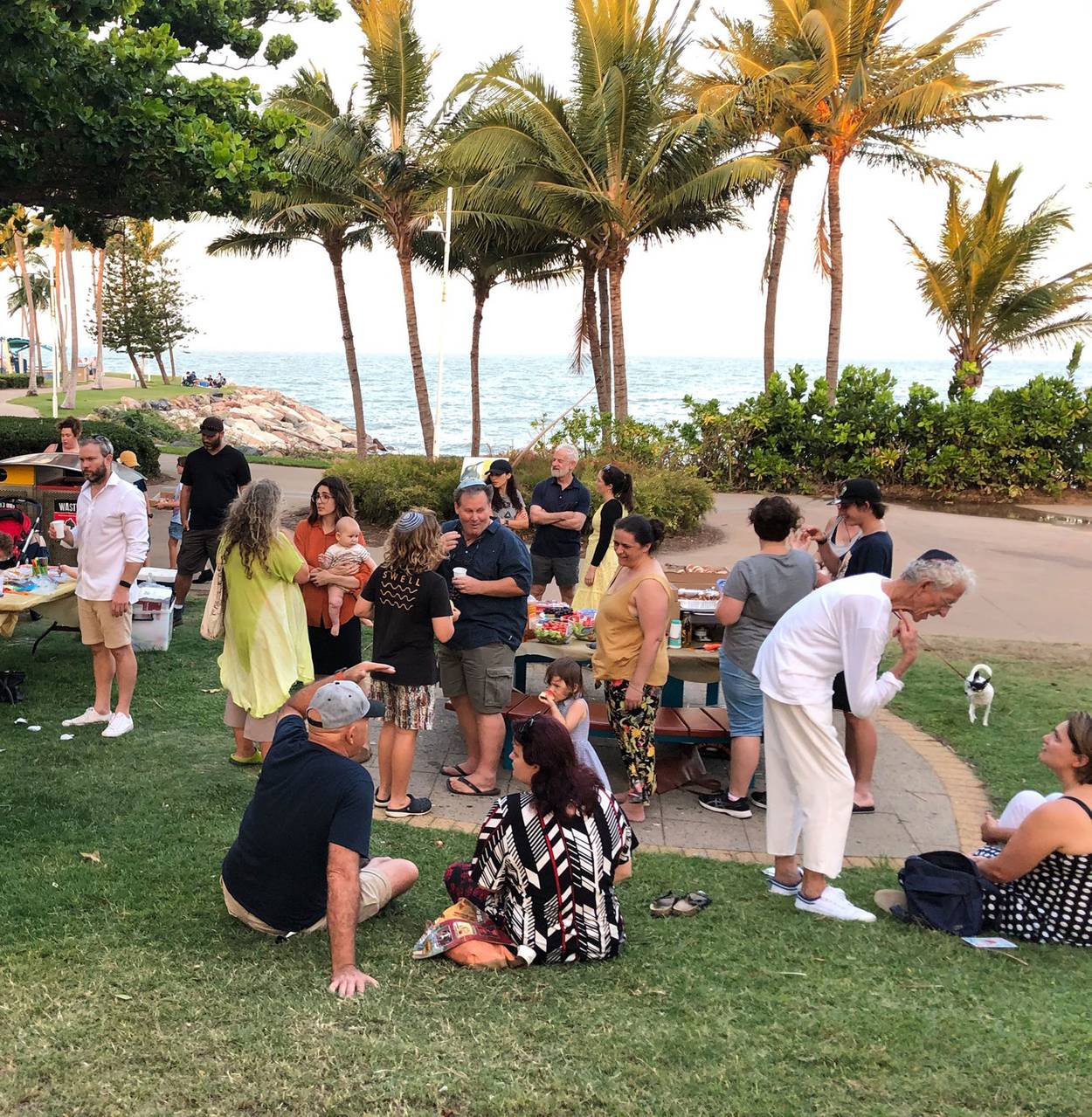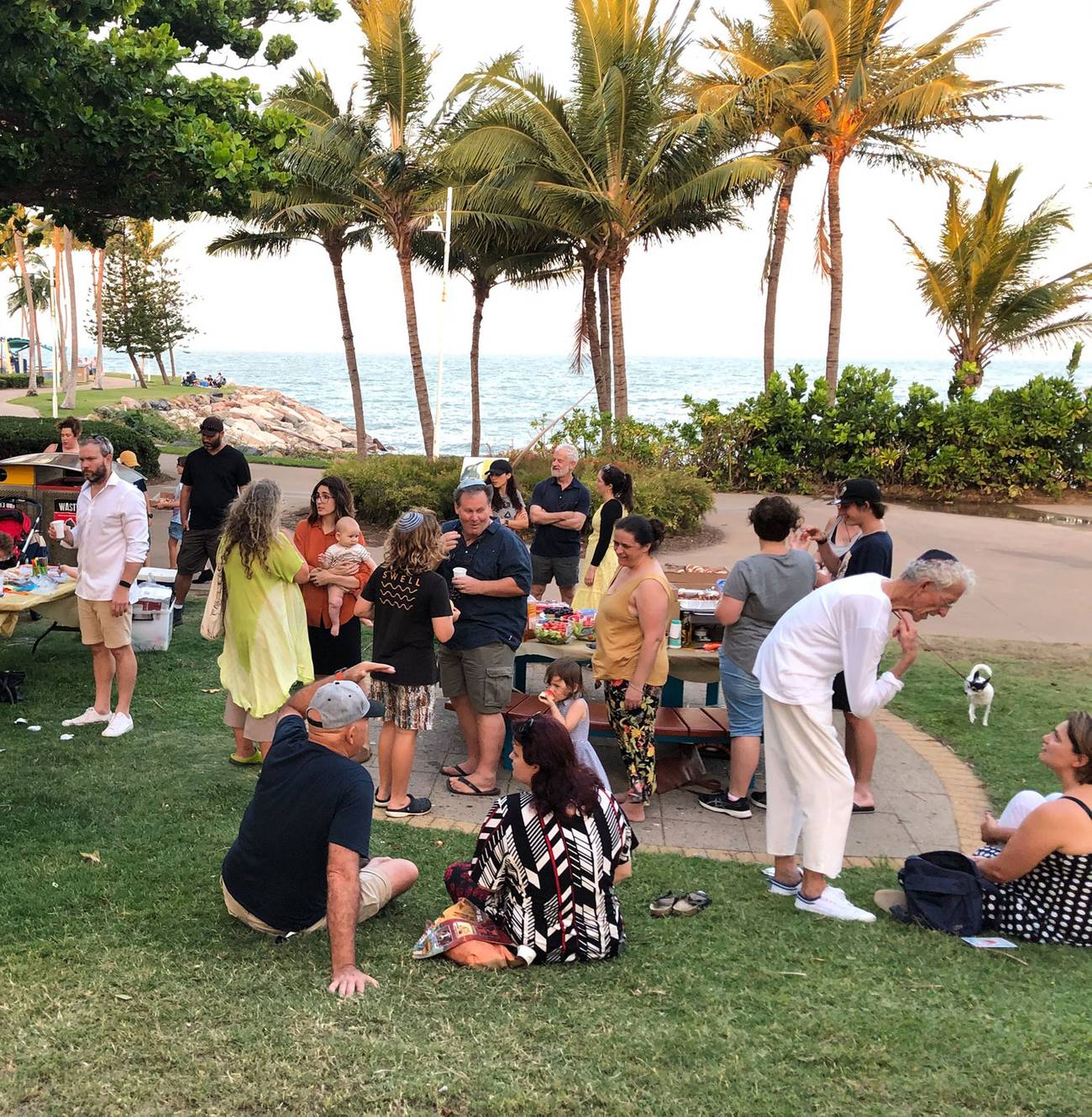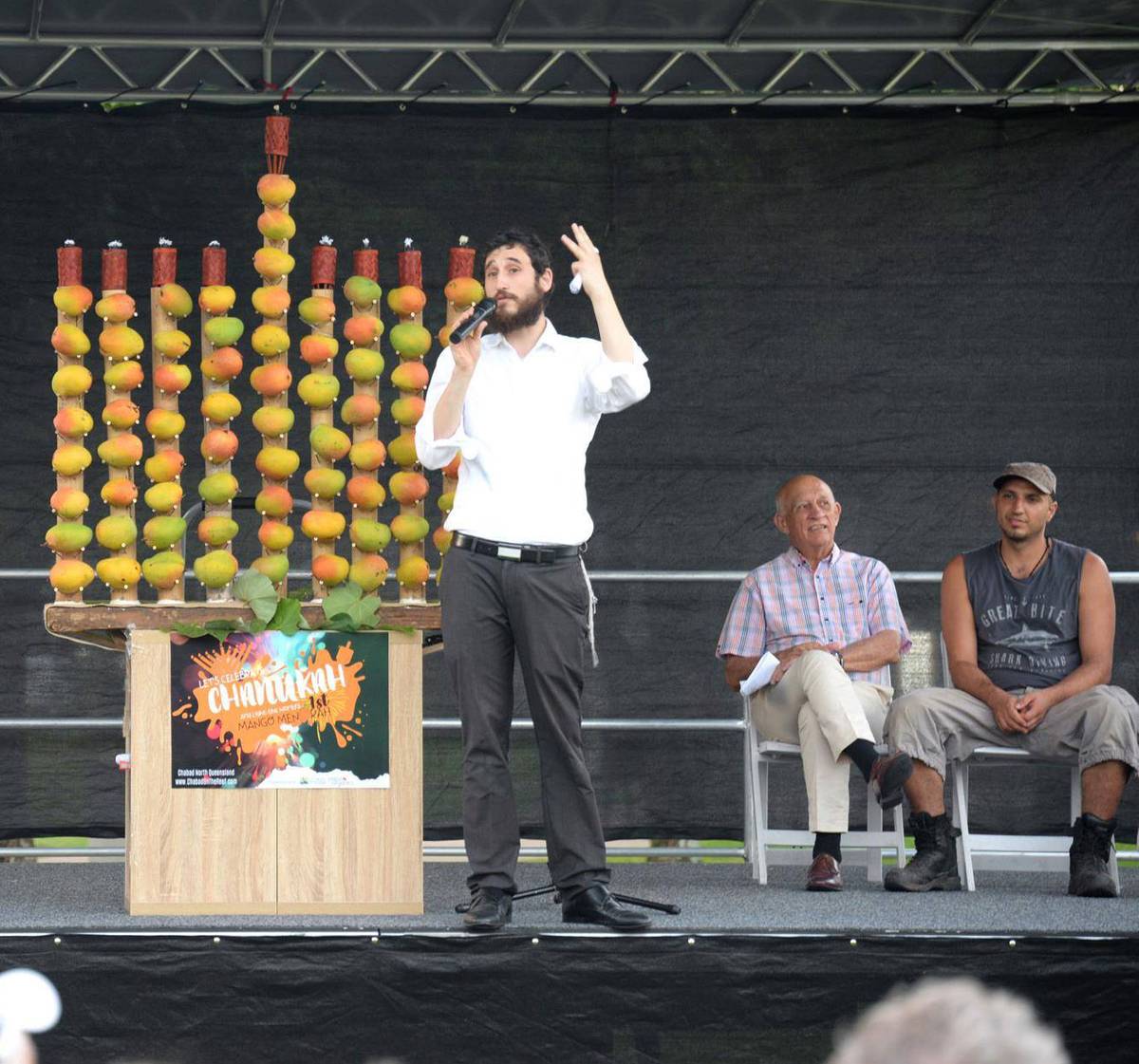When 99-year-old Holocaust survivor Ella Blumenthal celebrates Hanukkah, it’s very different than it was when she was growing up in Poland. These days, when she lights the candles—on a menorah salvaged from the Warsaw Ghetto—at a public lighting at the local synagogue, Beit Midrash Morasha, in Cape Town, South Africa, it is close to 9 p.m.; the sun sets late during what is the peak of summer. And it is hot, boiling hot outside.
Her granddaughter, Lior, who lives in Johannesburg, usually comes to spend time with Blumenthal over Hanukkah: “During the summer months, when Hanukkah usually falls, Johannesburg is deserted, everyone is on vacation,” she said, “so I come to the beach to spend time with my grandmother, and we usually celebrate Hanukkah together in the heat.”
While most Americans think of a white Hanukkah, which involves the usual wintry trappings of frost, coldness, early sunset, and snow, for Jews living in the Southern Hemisphere the summer temperatures offer different opportunities to celebrate this festival—such as fireworks, concerts, and celebrations in parks.
In Australia’s biggest cities, large “Hanukkah in the Park” events occur across the eight days of the festival, with locals enjoying barbecues, fireworks, and festivities. However, smaller festivities are also held in Australia’s regional cities.
In the tropical town of Cairns in the north of the Australian state of Queensland, for instance, Rabbi Ari Rubin makes the most of his unique location by infusing the festival with local culture.
This northernmost part of Australia is home to the Great Barrier Reef. During the Hanukkah period, which corresponds with the wet season in Queensland, the temperature is hot and the humidity is high. Using this inspiration, in 2019 Rubin had a huge menorah made of mangoes, the local fruit produced en masse in Far North Queensland.
This year, after seeking permission from the local aboriginal Australian custodians of the land, the Yidiny people, Rubin is using a menorah constructed from aboriginal Australian didgeridoos. A didgeridoo is an aboriginal Australian wind instrument, in the shape of a long wooden tube, blown to produce a deep sound and usually painted with traditional aboriginal art. “Didgeridoos symbolize Australia’s Indigenous people and we, the local Jewish community, wanted to showcase our connection to the local aboriginal people,” said Rubin. “The aboriginal elders we sought permission from to use didgeridoos for our menorah were very supportive and thought it was a great way to commemorate our freedom of religion in Australia, as well as emphasize the sense of kinship that many Jewish people feel with the Indigenous community.”
Rabbi Ari Rubin, who leads Chabad of North Queensland, and his mango menorah, Cairns, Australia, 2019Courtesy Rabbi Ari Rubin
The Cairns Esplanade, one of the main beachside streets in town, will be packed with Jews and non-Jews alike for the public menorah lighting and most people, due to the heat, will be clad in flip-flops, shorts, and lightweight clothing.
Rubin also takes his Hanukkah show on the road to other, smaller Jewish communities. Sami Hall lives more than 200 miles from Cairns in the coastal town of Townsville, where the Jewish community has only 70 full-time residents, and no formal synagogue or full-time rabbi. But Hall looks forward to Rubin arriving every Hanukkah to light the public menorah on one of the nights of Hanukkah in the main street.
“It’s not quite dark when the candles are lit, it’s just peaceful,” she said. “I don’t know how to describe it, I love the lighting of the candles and the reminder that God trumps all, no matter what adversity you face—you will survive it.”
Hall says that Hanukkah “makes me feel part of something greater as a Jewish person; while I am in my tropical paradise lighting candles, someone across the world is lighting candles in the frost and cold, and we are connected through this tradition.”
Across the Southern Hemisphere, Hanukkah regularly falls around the summer solstice, so menorah lightings typically start around 9 p.m., when the sun is finally setting. Neighbors get together and the gatherings often go well past midnight.
Elianne Ny, a 20-something from Uruguay, remembers attending Hanukkah celebrations each year on the capital city’s main boardwalk, the Rambla of Montevideo, an avenue that runs up the coastline. “For me, growing up in Uruguay, Hanukkah was always a time for family and is a very relaxed kind of festival,” she said. “The good side of having Hanukkah in the summertime means that Hanukkah is always chilled and relaxed.”
Most years, by the time Hanukkah begins, school is over for summer vacation in the Southern Hemisphere, so kids are free to stay up late all eight nights, partaking in the festivities.
“People are much more relaxed at this time of the year—people organize social activities and get together with friends,” said Ny. “It is a festival that lends itself to flexibility. You are already hanging out with friends so you light candles together.”
Around the Southern Hemisphere, Hanukkah traditions have been adapted. Rabbi Mendy Shemtov facilitates public menorah lightings across Uruguay—including in the beachside town of Punta del Este, which is a favored destination for many South American holiday-makers. He also puts a menorah in Uruguay’s airports to welcome global travelers on their vacations.
“When this tradition was first established, about 35 years ago, it was a novelty at the time as Uruguay was coming out of a dictatorship, so the fact that Judaism was celebrated publicly was a big deal,” said Shemtov. “This year, we will have a new menorah in Uruguay. We are getting a famous artist who works with steel [to create it] and that will become the public, central menorah in Uruguay. As well, there will be activities and events for families and children to participate in.”
But Hanukkah during peak summer is not all fun and games. Precautions must be taken depending on the location.
Rubin, a dual American and Australian citizen, laughs as he recalls the Hanukkah celebrations he experienced in the Northern Hemisphere over the years: “One year I remember going to hand out doughnuts on a street corner in Pittsburgh, when it was absolutely icy. My fingers were completely frozen while handing out doughnuts and the jam hardened in the doughnuts because it was so cold. However, in Far North Queensland, where I now live and serve as the full-time rabbi, you have fire bans and you can’t always have fire displays and fireworks because there are concerns they could spark bushfires due to the extreme heat.”
While Blumenthal has lived in South Africa for many decades and is now used to celebrating Hanukkah in the heat, she laughs affectionately at the different kind of festival she used to celebrate in the cold and frost of Eastern Europe. “The family menorah was placed indoors on a small stool next to the door because the windows were already frozen,” she said. “I recall my father lighting the menorah next to the entrance.”
This year, due to COVID-19 restrictions in South Africa, the celebrations may be a little more muted and smaller than in previous years. Blumenthal’s granddaughter Lior is not sure she will be able to travel from Johannesburg to see her grandmother and celebrate Hanukkah as they usually do. “I don’t know what I will be doing this year for Hanukkah,” Lior said, “but if I do end up in Cape Town, I will only see my grandmother from a distance to keep her safe.”
No matter what Lior decides to do, she knows one thing about her Hanukkah plans. “I will be somewhere warm, and I will keep my celebrations simple,” she said. “I’ve always loved Hanukkah for its enjoyable relaxed nature in the Southern Hemisphere. The simpler things are most enjoyable for me, so my festivities will be kept simple to allow me to engage with the miracles on a deeper, spiritual level.”


